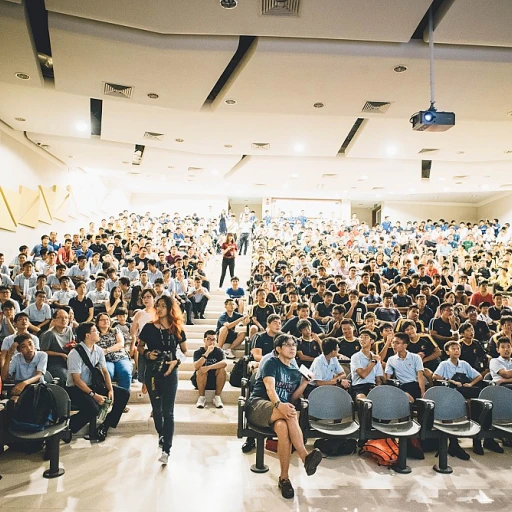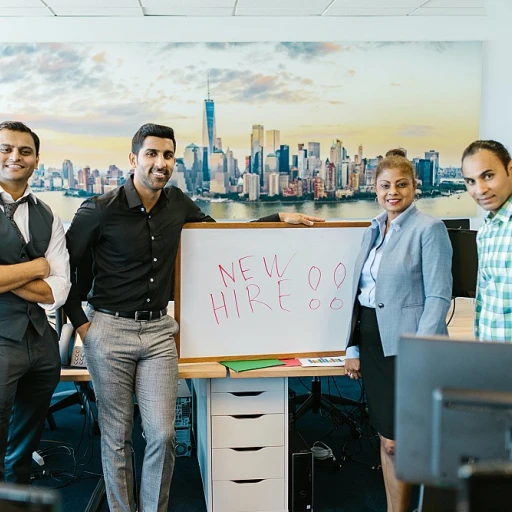
Defining Temporary-to-Hire in Tech
In the dynamic landscape of tech recruitment, the concept of temporary-to-hire (often referred to as temp-to-hire) is gaining significant traction. This approach facilitates a symbiotic relationship between employers and workers, where both parties can evaluate suitability before committing to a permanent position. But what exactly does temporary-to-hire involve, and why is it becoming a pivotal element in the tech hiring process?
Understanding the Temp-to-Hire Model
At its core, temp-to-hire is a staffing strategy where a company initially takes on an employee for a temporary period. During this time, both the company and the temporary worker assess whether there is a long-term fit. Essentially, the temporary worker has the opportunity to demonstrate skills and adapt to the company's work culture, while the employer evaluates the individual's performance and potential as a permanent employee.
This approach offers a trial period, which is particularly beneficial in the tech industry where the demand for skilled workers often requires swift and efficient decision-making. Temporary-to-hire positions provide employers the time to make informed hiring decisions without the immediate commitment of a full-time employment contract.
For tech professionals, this model can lead to long-term employment opportunities while allowing them to experience the company environment firsthand. Temporary employment can act as a stepping stone, helping tech workers transition into desirable permanent roles.
By leveraging temporary staffing, companies can significantly streamline their hiring strategies, ensuring they attract the right talent with minimized risk and reduced turnover. This adaptability is crucial in an industry that continuously evolves with new technologies and ongoing changes in workforce demands.
Benefits of Temporary-to-Hire for Employers
The Business Edge of Adopting Temporary-to-Hire
Temporary-to-hire recruitment in the tech sector offers a strategic edge for employers. By engaging in this approach, companies can navigate an often competitive hiring landscape with greater flexibility and efficiency. This not only ensures they have the right talent at the right time but also provides several other tangible benefits.- Reduced Hiring Risks: With temporary workers, there is an opportunity to evaluate performance in real-time, allowing decision-makers to make informed choices before offering permanent positions. This reduces the risks associated with direct hire mistakes.
- Cost Effectiveness: Hiring temp employees through a staffing agency can often be more cost-effective than managing the recruitment process entirely in-house. It minimizes upfront expenses often associated with full-time employment, including benefits and long-term salary commitments.
- Flexibility and Scalability: In the fast-paced tech industry, project demands can fluctuate. The ability to scale up or down quickly with temporary workers is invaluable. This flexibility ensures that staffing levels can adjust to current needs without the burdens of layoffs or lengthy hiring processes.
- Access to Specialized Skills: Tech projects often require niche skills. A temporary staffing model allows companies to hire job candidates with specific expertise on a short-term basis, fulfilling immediate project needs without the commitment of long-term employment.
- Improved Retention Rates: By initially evaluating a temporary employee's fit within the company culture and team dynamics, companies can enhance retention rates. Offering permanent positions to those who excel and fit well reduces turnover and associated costs.
Advantages for Tech Professionals
Exploring the Opportunities for Tech Professionals
For tech professionals, navigating the landscape of temporary-to-hire positions offers intriguing opportunities that can lead to long term career growth. While many tech workers initially take on a temporary role, the structured transition into a permanent position offers several benefits that enhance their professional journey. One of the principal advantages is gaining real-world experience without the immediate commitment of a full-time job. This allows tech professionals to dive into new technology and methodologies, expanding their skill set and increasing their marketability. Furthermore, working as a temporary employee provides a chance to explore different companies and industries. It allows individuals to gauge organizational cultures, project types, and teamwork dynamics, ultimately helping them decide what aligns best with their career aspirations. Temporary-to-hire roles often come with networking opportunities. These positions place tech professionals in environments where they can connect with diverse teams and influential figures in the industry. By fostering these relationships, temporary workers may find themselves with multiple job offers as their contract nears completion. Finally, companies using this staffing strategy tend to offer competitive compensation packages, acknowledging the specialized skills temporary employees bring. This not only supports financial stability in short-term work but can also set the stage for negotiations when transitioning to a permanent position. While engaging in temporary work, it's crucial for tech professionals to remain proactive in showcasing their abilities and fit for the organization. A strong performance during the temporary phase can significantly influence the company’s decision to extend a permanent hire, enhancing the overall hiring process. Understanding these positive facets empowers tech professionals to leverage temporary-to-hire positions as stepping stones towards fulfilling and sustainable careers. For more on how temporary positions impact employment checks, explore the effect of misdemeanors on background checks.Challenges and Considerations
Navigating the Complexities of Temporary-to-Hire
The process of transitioning from temporary work to a full-time, permanent position within the tech industry comes with its own set of challenges and considerations. For both employers and employees, understanding these intricacies is crucial to ensure the temporary-to-hire model is successful. One primary challenge involves the cultural fit. Temporary employees might initially perceive their positions as short-term, which can affect their integration into the company's work environment. Transitioning these positions to full-time employment means the organization must ensure that the temporary worker aligns with the company culture and values. Moreover, temporary staffing arrangements often necessitate a thorough assessment of the employee's performance during the temp job. This evaluation is critical as it determines whether the temporary worker is a good candidate for permanent hire. Employers must have structured feedback mechanisms in place to assess work quality and interpersonal dynamics. From the perspective of temporary employees, transitioning to a permanent role often raises questions about job security and benefits. During the temporary period, these employees may not receive the same level of benefits as their full-time counterparts, such as health benefits, retirement plans, or long-term job security. Therefore, it’s essential for staffing agencies and companies to communicate clearly about the potential for development and progression within the organization. Further complicating the process is the necessity to manage expectations. Both employers and temporary workers need mutual understanding regarding the timeline and criteria for converting a temp position to a full-time job. This involves outlining clear pathways and milestones that need to be achieved before an offer of permanent employment can be made. Finally, legal and contractual considerations must be navigated carefully. Employment contracts may require adjustments when an employee transitions to a permanent position, impacting terms of employment, rights, and obligations. Hiring processes must be meticulously managed to ensure compliance with labor laws and contractual obligations. The complexities of the temporary-to-hire model require careful planning and strategic implementation. Companies seeking to optimize this process must remain vigilant and proactive to ensure that temporary workers are successfully integrated into their long-term staffing goals.Best Practices for Implementing Temporary-to-Hire
Strategies for Successfully Implementing Temporary-to-Hire Arrangements
- Clear Job Descriptions: Clearly define the responsibilities and skills required for the temporary position. This sets the right expectations for both the company and the temp employee, ensuring a smooth transition if the job becomes a permanent position.
- Effective Communication: Maintain open communication channels between supervisors and temporary workers. Feedback mechanisms should be in place to address concerns and track progress throughout the temporary employment phase.
- Partner with a Reputable Staffing Agency: Collaborating with a reliable staffing agency can streamline the hiring process. Experienced agencies can help identify qualified candidates who align with the company’s needs and culture.
- Monitor Performance: Consistent performance assessments will help determine the temp worker's suitability for a potential long-term position. This not only helps the organization but also adds value to the employee's work experience.
- Consider Cultural Fit: A temporary employee can meet all job requirements but may not integrate well with the company culture. It’s crucial to assess if the candidate will thrive and contribute positively to the team dynamics over time.
- Transition Plans: Have a structured plan for transitioning a successful temp hire to a permanent role. This includes discussing full-time benefits, salary adjustments, and any changes in responsibilities.
- Use of Technology: Leverage recruitment technologies to track the progress and performance of temporary employees. This aids in making data-driven decisions about potential permanent hires.
Future Trends in Temporary-to-Hire in Tech
Emerging Trends in Tech Recruitment
The landscape of tech recruitment, particularly the concept of temporary-to-hire, is constantly evolving. As companies and workers alike seek more flexible employment arrangements, several significant trends are already reshaping this domain.- Remote Work and Digital Transformation: The acceptance and implementation of remote work have expanded greatly due to recent global events. This shift is now an integral part of tech recruitment strategies, including temporary staffing. Companies are increasingly open to hiring temporary employees who work remotely, leading to a broader talent pool and enhanced job satisfaction for workers who value flexibility.
- Rise of Specialized Tech Temp Agencies: With the demand for niche tech skills on the rise, more staffing agencies are specializing in sourcing temporary workers with specific technical expertise. This specialization helps companies fill temp job positions with highly qualified candidates quickly, and also supports temporary employees in finding roles that match their skills.
- Integration of Technology in Staffing Processes: The hiring process is becoming more streamlined and efficient through technology. Automated systems, powered by AI, are now integral in temporary employment practices, offering faster candidate matching and more personalized job placement.
- Focus on Diversity and Inclusion: The tech industry is increasingly prioritizing diversity and inclusion within temporary-to-hire practices. Companies are seeking broad hiring practices that give opportunities to underrepresented groups, aiming to foster a more inclusive work environment. This focus not only benefits societal diversity but also enriches team dynamics and company culture.
- Long-term Contractual Agreements: There is a noticeable trend towards long-term contractual agreements for temporary positions. Employers are structuring temporary staffing arrangements that give tech workers more stability, while still retaining the flexibility that temp work offers.












